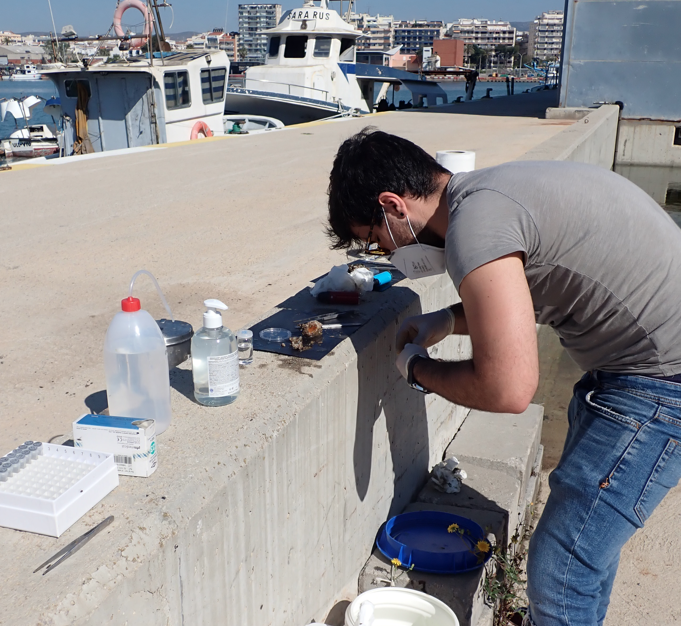Study suggests microbiome plays key role in invasive species success
Photos: Researcher Carles Galià-Camps during fieldwork / Image of the species Styela plicata (photos: UB-CEAB) 
Microbiome variability plays a crucial role in the ability of the ascidian Styela plicata to colonize new environments and cope with changing conditions, according to a paper published in the journal iScience. This variability of the microbiome helps account for its strong ability to proliferate, even in contaminated environments.
The work, which highlights the importance of taking these characteristics into account in the study and monitoring of potentially invasive species, is part of a doctoral thesis of Carles Galià co-directed by professors Marta Pascual and Carles Carreras, from the Department of Genetics, Microbiology and Statistics of the Faculty of Biology and the Institute for Research on Biodiversity (IRBio) of the UB, and Xavier Turon, from the Center for Advanced Studies (CEAB-CSIC).
The species Styela plicata is a type of ascidian, a group of invertebrates that live attached to substrates on the seabed and feed by filtering water and taking advantage of its organic particles. It is an invasive species that has spread globally, especially in ports and nearby coastal areas, harming native life.
The article reports the results of a research initiated in 2020 with the collection of samples of the ascidian Styela plicata and water samples in the ports of Barcelona, Blanes and Vilanova y la Geltrú. Using molecular techniques, the team has analyzed the composition and functionality of its microbiome in different tissues and stages of development.
"This is one of the novelties of the research because, until now, studies have usually focused on the most external part," says expert Carles Galià-Camps, a doctoral student at the UB and first author of the article. "The analysis of both the tunic (outer cover of the animal) and the gills and digestive tract (internal tissues) has surprised us: we discovered large differences depending on the tissue, both in the composition and functionality of the microbiome, showing a high specialization".
The comparison between juvenile and adult individuals has also revealed important differences. Thus, a correlation was found between the microbiome and heavy metals, especially in adults, which bioaccumulate these pollutants present in the water. This fact suggests that the communities of microorganisms and their functionality are changing during the development of the ascidian, responding better and better to environmental conditions.
As for the specimens from one or the other port, differences have also been observed, despite being very close geographical enclaves, suggesting a local adaptation.
Xavier Turon, CEAB-CSIC researcher and co-author of the study, explains that "the diversity and specialization of the microbiome is an advantage, since it allows these animals to adapt quickly, even in stressful and polluted environments. As with humans, we see that the microbiome is key to health, adaptation and evolutionary success."
Reference article:
Galià-Camps, C.; Baños, E.; Pascual, M.; Carreras, C.; Turon, X. "Multidimensional variability of the microbiome of invasive ascidian species." iScience, October 2023. Doi: /10.1016/j.isci.2023.107812
